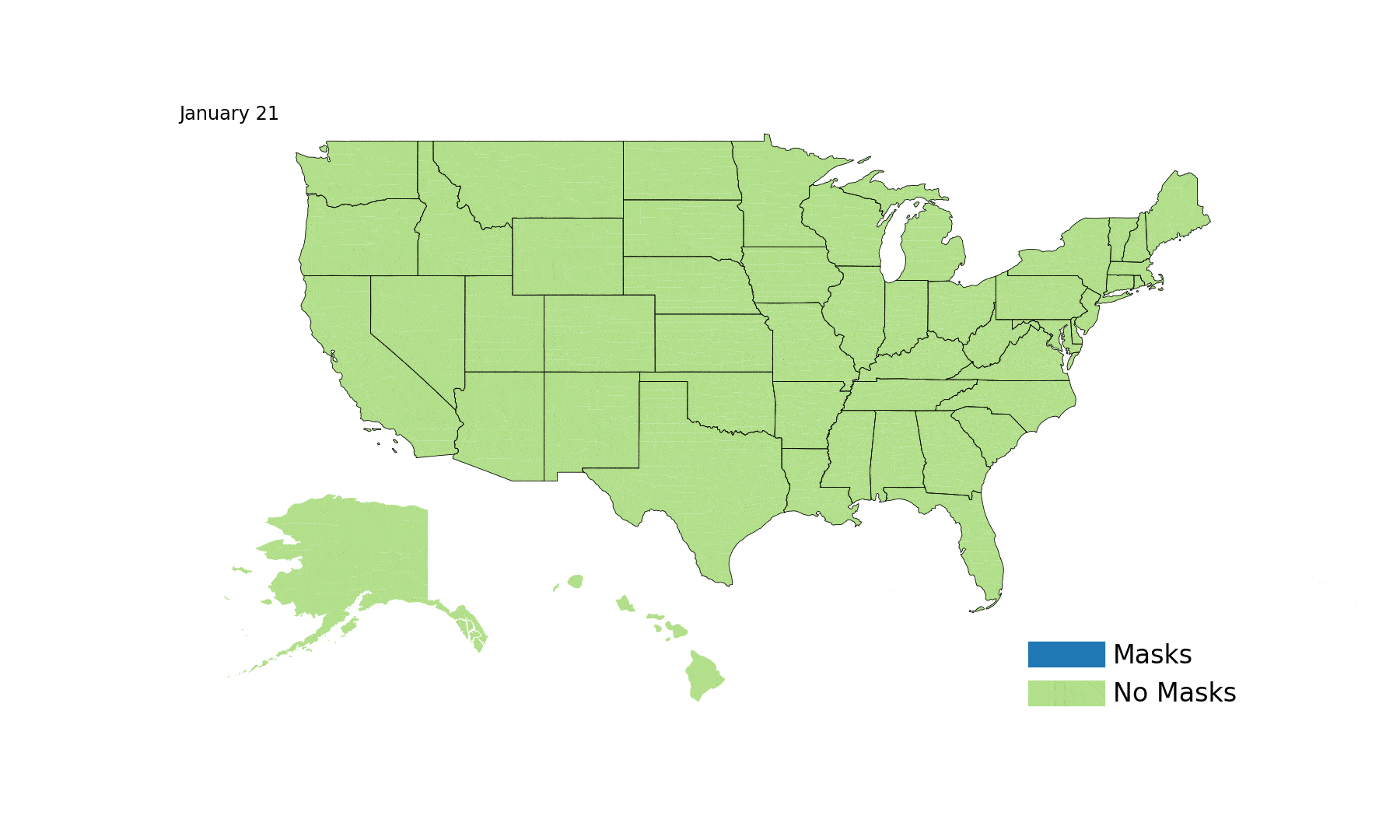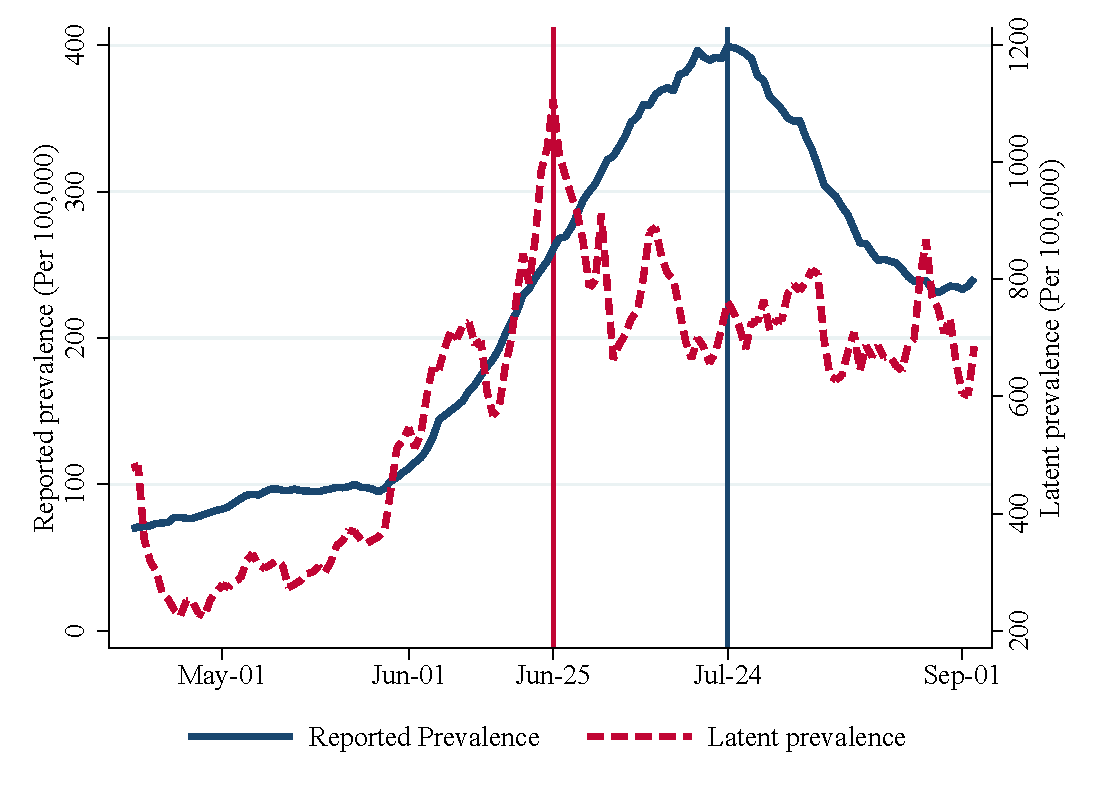We provide more information on these papers below. Citations for these papers are given here:

With Maclean Gaulin, Mu-Jeung Yang, and Francisco Navarro-Sanchez
Mask mandates reduce confirmed cases and can increase economic activity---if they are enforced at a state rather than county level.
We highlight the importance of signaling effects in determining whether public policy should be implemented at a decentralized or centralized level. For example, although a public policy may have the same direct effect if enacted at a state or county level, people may perceive these policies differently, leading to different indirect effects. We explore this mechanism using the patchwork of mask mandate orders in the U.S. from April to September 2020. State-wide mask mandates stimulate economic activity while also reducing COVID-19 case growth. Surprisingly, county-level mask mandates generally have the opposite effect, depressing economic activity. We argue that different unintended signaling effects can explain these differences in policy effects: households infer from county mask mandates that infection risks have increased in their local area and, therefore, socially distance more and spend less. In contrast, state mask mandates do not lead to similar local inferences, and thus overall, they stimulate the economy.

With Matthew Samore, Adam Looney, Brian Orleans, Tom Greene, Julio C Delgado, Angela Presson, Chong Zhang, Jian Ying, Yue Zhang, Jincheng Shen, Patricia Slev, Maclean Gaulin, Mu-Jeung Yang, Andrew T. Pavia, Stephen C Alder
This project's aim was to generate an unbiased estimate of the incidence of SARS-CoV-2 infection in four urban counties in Utah.
This project's aim was to generate an unbiased estimate of the incidence of SARS-CoV-2 infection in four urban counties in Utah. A multi-stage sampling design was employed to randomly select community-representative participants 12 years and over. Between May 4 and June 30, 2020, surveys were completed and sera drawn from 8,108 individuals belonging to 5,125 households. A qualitative chemiluminescent microparticle immunoassay was used to detect the presence of IgG antibody to SARS-CoV-2. The overall prevalence of IgG antibody to SARS-CoV-2 was estimated at 0.8%. The estimated seroprevalence-to-case count ratio was 2.4, corresponding to a detection fraction of 42%. Only 0.2% of individuals who had a nasopharyngeal swab collected were reverse transcription polymerase chain reaction (RT-PCR) positive. The prevalence of antibodies to SARS-CoV-2 in Utah urban areas between May and June was low and the prevalence of positive RT-PCR even lower. The detection fraction for COVID-19 in Utah was comparatively high. Probability-based sampling provides an effective method for robust estimates of community-based SARS-CoV-2 seroprevalence and detection fraction among urban populations in Utah.


With Mu-Jeung Yang, Maclean Gaulin, Adam Looney, Brian Orleans, Andrew T. Pavia, Kristina Stratford, Matthew Samore, and Stephen C Alder
Revise and Resubmit, Review of Economics and Statistics.
We provide a method to track active prevalence of COVID-19 in real time, correcting for time-varying sample selection in symptom-based testing data and incomplete tracking of recovered cases and fatalities.
We provide a method to track active prevalence of COVID-19 in real time, correcting for time-varying sample selection in symptom-based testing data and incomplete tracking of recoveredcases and fatalities. Our method only requires publicly available data on positive testing rates incombination with one parameter, which we estimate based on a representative randomized sample ofnearly 10,000 individuals tested in Utah. The method correctly predicts prevalence in two state-wide,representative randomized testing studies. Applying our method to all 50 states we show that trueprevalence is 2–3 times higher than publicly reported.

With Mu-Jeung Yang and Maclean Gaulin
We show that the quality of information matters for how people respond to information about COVID-19.
We combine structural estimation with ideas from Machine Learning to estimate a model with information-based voluntary social distancing and state lockdowns to analyze the factors driving the effect of social distancing in mitigating COVID-19. The model allows us to estimate how contagious social interactions are by state and enables us to control for several unobservable, time-varying confounders such as asymptomatic transmission, sample selection in testing and quarantining, and time-varying fatality rates. We find that information-based voluntary social distancing has saved three times as many lives as lockdowns. Second, information policy effects are asymmetric: `least informed' responses would have implied 240,000 more fatalities by June 2020 while `most informed' responses would have saved 25,000 more lives. Third, our estimates suggest that contagion externalities from social interactions are large enough that a lockdown response could have been 25\% less costly for the median state and still saved an equivalent number of lives.

With Maclean Gaulin, and Mu-Jeung Yang (available upon request)
Personal data sharing can be motivated through incentives or different instrinsic motivations. We consider these effects in the context of getting tested of COVID-19.
Personal data markets have become ubiquitous. At the same time, the non-rivalry of data suggests that the social returns to personal data sharing will often exceed its private returns. Using a unique sequence of exogenous program evaluations for randomized COVID-19 testing among over 10,000 individuals in Utah, we analyze different tools to stimulate personal data sharing. We contrast the effectiveness of incentives for data sharing with mechanisms suggested by behavioral economics, including framing, image motivation, and identity. Our results suggest that incentives by themselves can easily backfire and are highly complementary with framing effects. Furthermore, image motivation and identity are an order of magnitude more effective in influencing data sharing than monetary incentives.